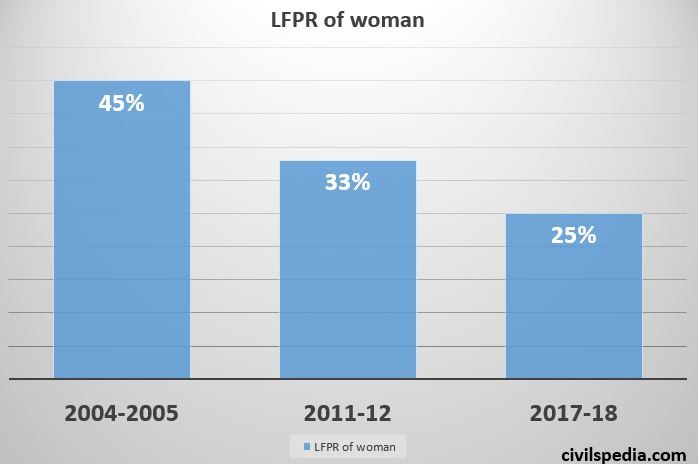Table of Contents
Low Female Labour Force Participation
This article deals with ‘Low Female Labour Force Participation.’ This is part of our series on ‘Society’ which is important pillar of GS-1 syllabus . For more articles , you can click here .
Introduction
- LFPR of women is continuously decreasing . In 2017-18, LFPR among women was just 25%.

- Only in Meghalaya , women LFPR was above 50% .
Possible reasons for low Woman LFPR
- Social Causes
- Patriarchal Mindset : Patriarchal norms of Indian society and social constraints on freedom of women results in lower LFPR among women.
- Nuclearisation of families : childcare and household work restricts woman participation in work.
- Caste factor : in some upper castes, there is a stigma attached to women working outside the home .
- Many sectors like Armed forces arent open for women .
- Unpaid household work : Economists distinguish between production for self-consumption and production for the market. Only the latter is counted as ‘work’. Most of woman are working at home, but since it is unpaid, it is not counted in labour force participation.
- Rising incompatibility of work : Due to structural change in Indian economy , skilled jobs in service and construction sector coming up but women don’t have necessary skills for these jobs .
- Higher Education : As women are pursuing higher education, their entry in the job market is delayed (Feminization U-Hypothesis ( given below)).
- An income effect of the husband’s higher earnings. Rise in the income of men has resulted in withdrawal of women from the labour market.
- Violence against woman force woman to move out of labour force . Eg :
- Violence against woman at workplace restricts their participation.
- Mode of transportation is not safe for woman restricting their movement.
- Problems like looking after young child, lack of crèches facility at workplace etc. force working mothers to quit job .
Feminization U-Hypothesis
With development,
- Women’s labour force participation drops during the initial phase of industrialization .
- But in long run, Labour Force Participation will increase once a certain level of development is reached.
Steps ahead
- Bangladesh Model – Promote Apparel & Shoes Sector as these two sectors are most women friendly .
- Open more sectors for woman : eg Defence Services etc.
- Skilling woman so that they can fit in post LPG Reforms economy .
- Promoting woman entrepreneurship : Via Standup India and many other schemes .
- Maternity Benefits : Government has already increased it to 26 weeks. Extend it to informal sector as well.
- Self Help Group (SHG) promotion like Kudumbshree to make women especially in rural areas to be self-employed.
- Japan Model (Womenomics) : It includes getting more women into positions of leadership.
- Reshaping societal attitudes and beliefs about women participation in the labour force.
Side Topic : Women in leadership roles in India
- Women representation on company boards in India is also very low at mere 13.8% .
- But this number is gradually increasing, which is a very positive sign. Many big corporates are headed by women, example Pepsi by Indra Nooyi, Axis Bank by Shikha Sharma, ICICI Bank by Chanda Kochhar (who just quit) etc.
- In 2020 , Germany has made mandatory quota for minimum number of women working in senior management positions in the country’s listed firms.
Reasons for lack of women in leadership role
- Glass ceiling Effect : It restricts the promotion of women to the top most positions. This glass ceiling exists due to the persistence of patriarchy in the society, and also due to the fact that the present leadership consists of men who promote the interests of men only
- Leaky Pipeline Effect : Tendency for the proportion of women to decline as management grade rises .
